On Black Squares: Non-referentiality and Blackness
Two years after “Blackout Tuesday,” where social media users were called upon to post a black square in solidarity with protests unfolding across the US for Black lives, artist manuel arturo abreu reflects on the viral phenomenon in relation to the 2015 discovery of a “racist caption” in Kazimir Malevich’s Black Square. More meditative than conclusive, and departing from a tweet from Aria Dean, abreu considers various arguments ranging from the politics of captioning to the implications of non-referentiality.
Blackout
On June 2, 2020, at least 28 million social media users1According to Forbes. link posted black squares, expressing that they would not be posting for the rest of the day because #BlackLivesMatter. This mass behavior stemmed from #TheShowMustBePaused, an initiative devised by two Black music executives—Brianna Agyemang and Jamila Thomas—calling for businesses to cease operations for the day and for their followers to engage in other gestures in support of BLM.2See https://www.theshowmustbepaused.com/ Due to principles of distortion as old as the kids’ game Telephone, #TheShowMustBePaused became “Blackout Tuesday,” decontextualized from its original context of the music industry to apply more generally to all aspects of user activity (ie the product or site of value of social media apps). The posting of the black square and nothing else for the day was considered a refusal of “business as usual” (presumably akin to the music industry-specific initiative). After a flurry of critiques around performative activism, however, many users retracted their statement, deleting their black square posts.3link
Artists were quick to recognize the visual resonance of Blackout Tuesday’s Black Square with Russian artist Kazimir Malevich’s Black Square (1915).4A canonical work of early modernist abstraction consisting of a black square framed by unpainted white canvas. Beyond the purely formal (both are black squares), some located a discursive similarity between the summer’s Blackout Tuesday moment and the 2015 “discovery” of a racist inscription “under” Malevich’s Black Square (the link being, perhaps, ‘both are racist,’ or ‘both are performative,’ or something along these lines). A 2020 tweet from artist and curator Aria Dean prompted further investigation into this comparison. Dean’s view being that sometimes a joke is the best way to do philosophy.5“A serious and good philosophical work could be written consisting entirely of jokes.” Ludwig Wittgenstein, as quoted in Dribble 2004: 87.

Kazimir Malevich, Black Square (1915)
Some context: in 2015, the Moscow State Tretyakov Gallery announced that X-Ray analysis had apparently uncovered a racist caption in the margin of Malevich’s painting, which possibly read “Battle of the Negroes” in Russian. Headline grazers immediately assumed that the found caption was located under the square, when in fact it was scrawled on the white margins. Dean’s designation of the “easy joke” draws together not just formal resonances (black squares), but also yokes the knee-jerk reaction of users rushing to post the decontextualized Black Square in a virtue-signaling gesture to the soundbyte format and goldfish memory of the digital news cycle, which allows decontextualized statements like “Malevich wrote a racist inscription” to become prominent and accepted on the basis of outrage marketing.6Outrage Marketing is described as a viral marketing trend whereby corporate call out becomes rather an effective strategy for generating users’ attention. See more here. We could say that libs “sought refuge” in the Black Square, the same way Malevich did.7“In 1913, trying desperately to liberate art from the ballast of the representational world, I sought refuge in the form of the square.” Key to regarding decontextualization in Malevich’s case, at least on some accounts8For example, Irina Vakar analyzes things this way. See Vakar, “New Information Concerning The Black Square” in Lodder, Christina (ed.) 2019. Celebrating Suprematism: New Approaches to the Art of Kazimir Malevich. Leiden, The Netherlands: Koninklijke Brill NV, is whether he himself was thinking through a racist genealogy linking his gesture to the French satirists Paul Bilhaud and Alponse Allais. I personally have doubts, given the work’s non-referential intent. If the work is racist, it is in its non-referentiality, not in the reference of the caption. In what follows, I try to explore the decontextualizing network dynamics at play in this nexus of Blackout Tuesday and the Black Square, as well as underscore the non-referentiality at play in Malevich’s work.
In thinking through this juxtaposition, I have found myself always hungering for more context, lacking many answers or concrete ground. In writing this article I was unable to find the definitive link between the music industry-specific initiative started by two Black women, to the call for the general social media user base to post a black square. Similarly, I never found definite proof that Malevich himself made the racist inscription reported in the news.9I couldn’t find the critical link in the chain when #TheShowMustBePaused morphed into Blackout Tuesday. Whatever faults people may find with the latter– and people found many– cannot be placed on the two Black women who drafted the former, whose industry-specific initiative was largely unrelated to user activity; however, it is true that both Blackout Tuesday and many business gestures from #TheShowMustBePaused were largely symbolic rather than materially impactful to Black people. This too remains a resonance, a byproduct of the “long tail” of the indexed web and the inevitability of linkrot with digital research. What remains to link two cases is the shape of a black square, and the sense that if context is a material, so is lack of context. This leads me to ask what a caption—vandalized or otherwise—does, or performs, to yoke potentially non-referential gestures back into the world of reference. The opposite of orthography may be cacography.
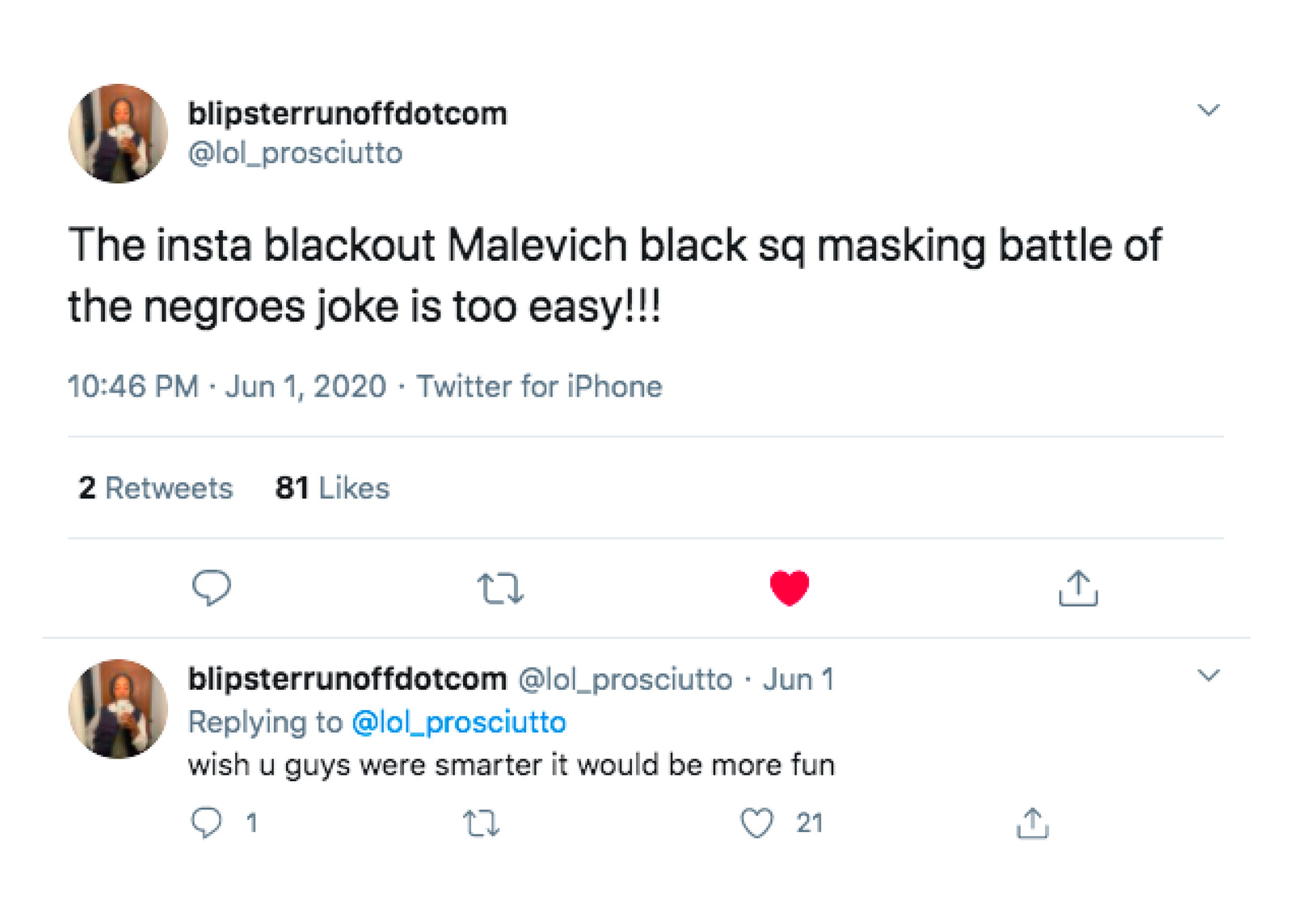
Screenshot of tweets from Aria Dean’s Twitter account. Image courtesy the artist.
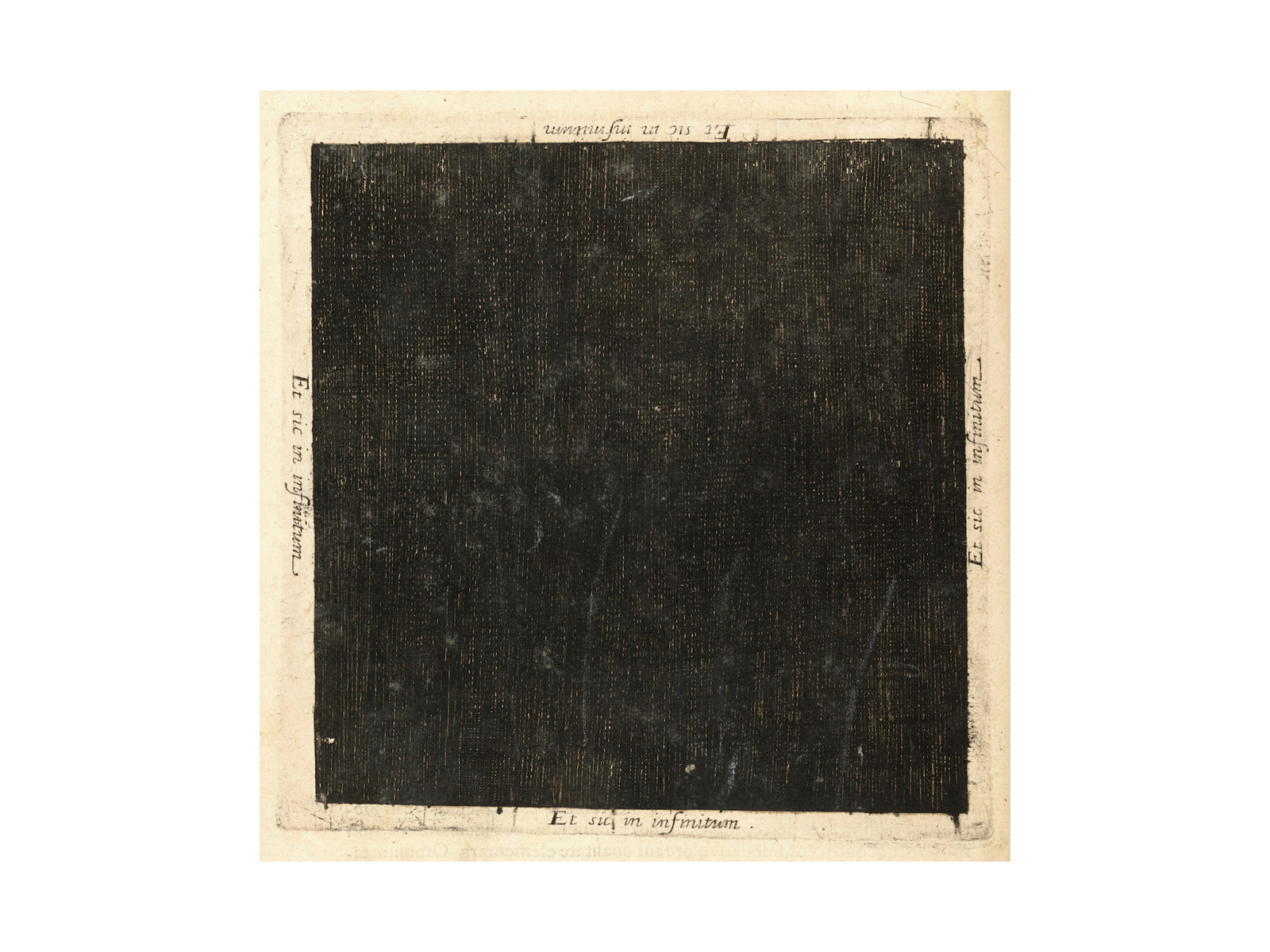
Robert Fludd’s black square in Utriusque cosmi maioris scilicet et minoris metaphysica (The history of the physical and metaphysical cosmos) (1617). In this image, Fludd attempted to capture infinity: “Et sic in infinitum” is inscribed across each of the four sides.
The Myth of Abstraction
Of his Black Square, Malevich himself said: “The square = feeling, the white field = the void beyond this feeling.”10Malevich, Kasimir. 1927. Suprematism. In The Non-Objective World, published in Germany as part of the Bauhausbücher series. Like many modernists, Malevich saw the material and spiritual practices of African and Amerindigenous people as sites of escape from rationalism. White = disembodied reason, Black Indigenous Asian Brown = embodied unreason or caprice. Of his deeply affecting 1907 Trocadero Museum trip, Picasso described: “The African pieces were intercesseurs… They stood against everything, the whole; against the unknown, threatening spirits. I was always looking at fetishes. I understood; I too am against everything. I too believe that everything is unknown, that everything is an enemy! … all the fetishes were for the same thing. They were weapons to help people avoid obeying the spirits so they could become free.”11As quoted in Malraux 1976. However, we can at least say that these formative figures of 20th century modernism were honest about the impact Black had on them. BIPOC navigators of the so-called art world remain at pains to decide whether the honest colonial and post-colonial modernist—say, Picasso grabbing Leopold Senghor’s arm and saying “always remain a savage”—is worse, or whether the wheedling passive aggression and fundamental dishonesty or concealment or the “contemporary” artist is worse… But that’s another essay.
The suprematist square and the forms proceeding out of it can be likened to the primitive marks (symbols) of aboriginal men which represented, in their combinations, not ornament but a feeling of rhythm.”12Malevich, Kazimir. The Non-Objective World: The Manifesto of Suprematism. Chelmsford, MA: Courier Corporation, 2003: 76. The painting’s two color zones have deep symbolic meaning for the artist in this modernist vein. Thus Malevich’s racism is already embedded in his mode of symbolic deployment. The Black Square is racist, but not on the basis of a caption of questionable authorship. Rather, it’s on the basis of ideas of Africa and Blackness relating to negation, void, feeling (as opposed to reason).
I have done plenty of work rejecting the European origin myth of abstraction13I point interested readers to “Against the Supremacy of Thought” (Rhizome, 2018) and An Alternative History of Abstraction (digital video, 1’58”, 2020), therefore I don’t feel the need to contribute to “The Black Square is racist” discourse. The reality is, it’s an important work for me personally in my artistic development—whatever problems we might point out. I don’t write this to justify the pedantry that arguably follows. I really did grow as a young teen artist through learning about Malevich, including this work. This essay, you could say, might be a kind of exorcism?
Since the above already discusses Malevich’s potential racism in a non-referential domain (i.e. it’s racist to say white = void of disembodied reason and Black = fullness or excess of embodied unreason) attending to the caption (and, by way of captions and citationality, to the nexus of Blackout Tuesday and the Black Square) can serve different ends. Intently personal ends, we might say: perhaps black square(s) can be a site to reflect on my hunger for context in general, and on the generalized need to refuse consumable narratives, the contours of the attention economy, and ad hoc genealogies.
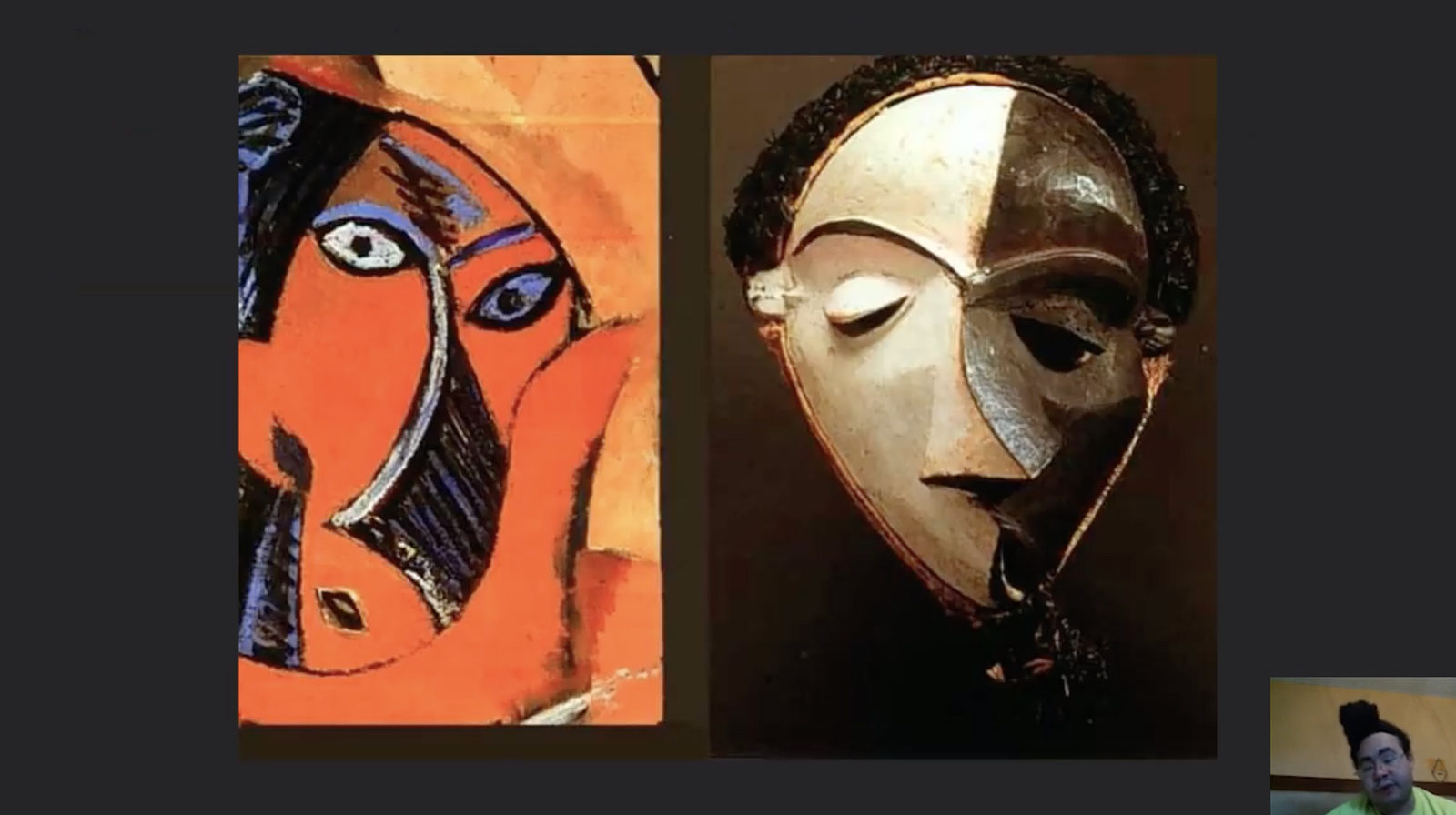
Still from An Alternative History of Abstraction by manuel arturo abreu (2020). This particular slide makes associations between Pablo Picasso’s Les Demoiselles d’Avignon (1907) and a Mbuya mask from the Pende tribe of the Congo.
The Black Square Effect
This text is then an open question—a contemplation on the caption specifically, which is in the white margin, not the black square. Through this, we can begin to formulate a “black square effect.” In hearing the news of the caption’s discovery, many assumed the inscription was under the square itself—the black bar of redaction and censorship an easy pun—when in fact the State Tretyakov Gallery had announced that X-ray analysis revealed that “in one of the margins a partially lost inscription by the artist was discovered”14 Voronina, Y.A. and Rustamova, I.V. “Results of a technological investigation of The Black Suprematist Square by K. S. Malevich,” in Vakar 2015. (italic emphasis mine). The inscription being in the white border of the work rendered the margin a space of caption (regardless of Malevich’s intention), as well as a space of claiming an aesthetic genealogy back to Bilhaud and Allais. It wasn’t under the black square, so why did people think it was? Is there a way to inspect this dialectic of decontextualization by looking at this caption more closely?
The outrage (of a possible racist art historical reference under the work) leads us to questions of unclear authorship, vandalism, decontextualization, the contemporary news cycle, and symbolic gesture. Regardless of people’s headline-grazing, hate-reading, or deep-diving, the discourse also actively participates in today’s conversations regarding remix culture, redaction, and surveillance aesthetics, and the fight to change the art industry’s whiteness. However, the anti-Blackness of the Black Square is a non-referential, not referential, one: it dives into obscurity, fungibility, and illegibility, rather than categorization. Exploring the contours of this issue, Hannah Black argues: “The art historical rupture of the Black Square… turns out to rest, like so much of the history of modernism, on the illegibility of Blackness. The painting masquerades as the negation of representation, but in light of the joke about darkness, negation itself becomes representation; what is represented is the nothingness of certain subjects…”15Black, Hannah. 2016. Fractal Freedoms. Afterall 41. In the general sense of the coloniality of art history, and indeed, as our quotes have shown, in the sense of the meanings of black for Malevich (i.e. in relation to void, night, negation, primitiveness, nonsense, liberation from representation), these arguments ring true. However, as mentioned, the particular case of Malevich leaves me unclear on whether he actually made the inscription, just as I couldn’t find the critical link for the decontextualization of #TheShowMustBePaused. It’s almost as if Malevich’s black square experienced the Blackout Tuesday effect (scaled decontextualization). But then, the question of whether that link is actually critical (analogous to whether it matters if Malevich made the inscription or not) might be a question of scale—that is to say, in some obscure way, these questions of scale and form are a part of Dean’s joke.
The joke is a minimal form. Dean often works with the forms and language of minimalism to surface critical questions about form and scale. When Dean thinks and images race, she thinks of a race: in her e-flux essay “Notes on Blacceleration,” for example, she speaks of accelerationist principles as always already Black. And in her short moving image work Eulogy for a Black Mass (2017), she elaborates the Blackness of memes and the memetic. Blackness as poor image, and therefore as engine of circulation, speaks to legacies of relation both forced and chosen, in what Nairobi-based philosopher Keguro Macharia calls “the forced proximity of the hold of diaspora” in his sensational text Frottage (2019). If we picture modernism and the rise of industrial reproduction as somehow connected, then the postmodern minimal and the pop hyperconsumptive—at the Blackout Tuesday scale, perhaps, of 28 million or more—continue to rub up against each other. A “Black” frame and aesthetic began with the “love and theft”16Eric Lott. See also David Roediger on corking up. of Blackface as a site of excess for non-Black people to perform affect that was unsanctioned in mainstream society. Alongside this wasthe sharecropping-era deprivation and destruction of Black sites of wealth and the racist labor practices of the vaudeville performance circuits.
With all this talk of representation and performance, it’s worth returning to Hannah Black. Indeed, her argument is high level, and I basically agree—here, Malevich’s racism hinges on non-representation. This is why the caption’s “author function”17 Foucault said the author was a function of the discourse (“What is an Author?”, 1969). is of interest to me (or is it peoples’ obsession with pinpointing the authorship that interests me?). The artist’s intent is that the Black Square is nonreferential (it’s not a painting of something, which given his previously-quoted words implies that feeling is nonreferential and therefore its anti-Blackness cannot be of either—that is to say, it’s non-referential racism). Clearly, an authorial intended caption does the work of rendering the painting referential.
A caption is a brief textual phrase that explains what it captions. Therefore, what it captions has meaning or reference to explain. In this context, the impact would be that if Malevich captioned his work, it is actually of something, or has a reference. Therefore, it may be important to attend to the validity of the claim, at least for someone influenced by this work, like me. Did Malevich actually make this inscription? Based on the legacy of his work and the details of its discovery (which I will get into) I don’t think he did. And what this means is that the work, as intended, is indeed nonreferential, and therefore if it’s antiblack (which I think it is), it is on this nonreferential basis,rather than on the basis of a genealogy with Bilhaud and Allais, which are referential in that their racism). At a higher level of argumentation, the idea of the nonreferential gesture in general is not only steeped in racist thinking about “primitives,” but, as Black notes, the negation of representation is a kind of masquerade for other things that are going on. Here what she writes resonates with sociologist Orlando Patterson, who argues in his foundational Slavery and Social Death (1982) that parasitic enslavers project their parasitism onto host societies (enslaved peoples). Ironically, the caption itself is parasitic on context (or perhaps on lack of context).

Still from Eulogy for a Black Mass by Aria Dean (2017).
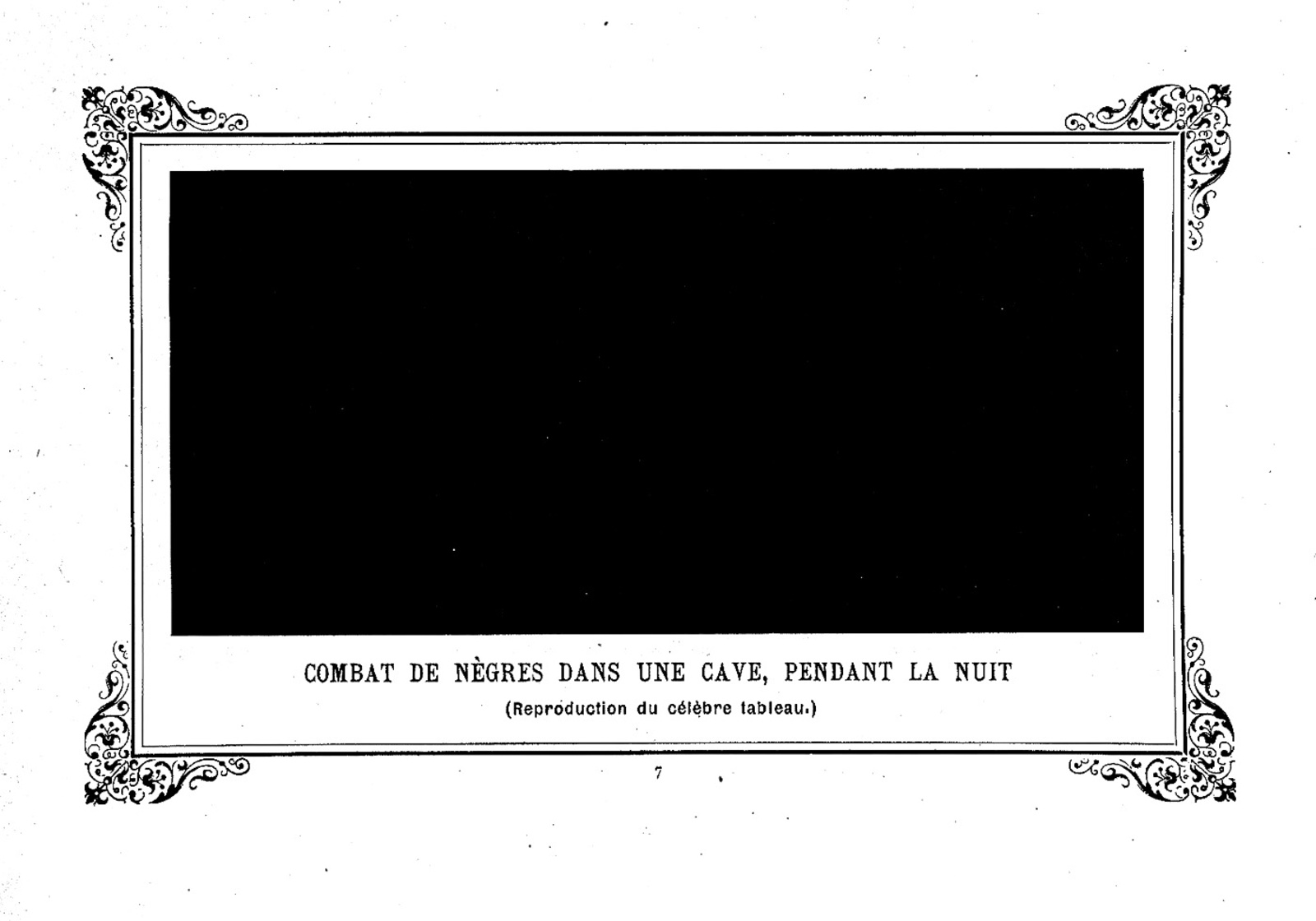
Paul Bilhaud (after), Negroes Fighting in a Cellar at Night in Album primo-avrilesque (April fool-ish Album), by Alphonse Allais (1897)
The Caption
If you don’t care about the caption itself, just skip to the next section.
To the right is the clearest available picture of the caption I could find. I can see the first two words “битва негров” (“Battle of the Negroes”) in handwriting. Below is a rendition of the print Cyrillic, which is visible to me in the above screenshot, rendered in cursive script:

Cursive rendition of битва негров generated by coo.by.
Russian cursive writers use the macron to distinguish the cursive “T” from the cursive “M,” as seen in the Black Square margin inscription. The State Tretyakov Gallery researchers argue that the entire Russian equivalent of the Bilhaud and Allais’ French is there: “Битва негров в темной пещере глубокой ночью.” And further, they argue that the inscription is by the artist’s own hand. Irina Vakar goes on to argue on the basis of this ostensible authorship that the Black Square definitively, intentionally relates to 19th-century captioned monochrome works by Bilhaud and Allais (A Battle of Negroes in a Cave at Night, 1897), which is to say that the aesthetic genealogy back to Les Arts incohérents was intended by Malevich. This is certainly provocative art history. And presumably the significance of this is to knock the work off of its pedestal, so to speak. By the artist’s own hand or intent, it’s not only not abstract; it’s of something, and finally—a woke nail in the coffin—due to this intentional caption and its hearkening back to 19th-century French absurdism, the Black Square (1915) is anti-Black. Of course, the work’s stature is only at stake along these claims if one cares about the meaning of the work in Western art history. It’s also clear that the work in its definitively-established non-referentiality is also already invested in strange ideas regarding white = disembodied reason and Black = embodied feeling /unreason. What gives, then? How might all this Malevich stuff relate to Blackout Tuesday, soundbyte culture, and 20th century pinko propaganda from both US Hollywood and Soviet avant garde art?
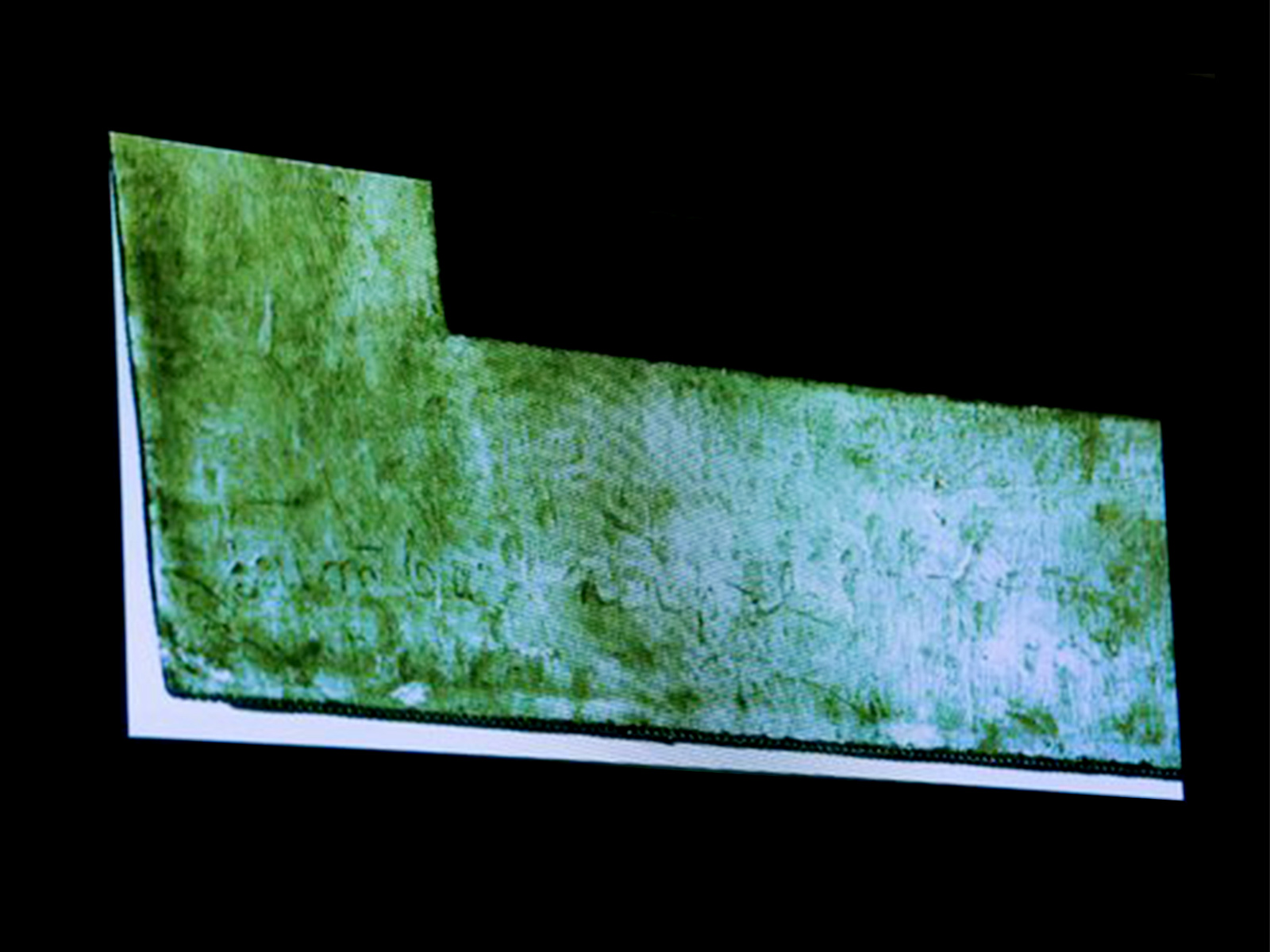
X-ray scan revealing an inscription in pencil in the lower left margin of Malevich’s Black Square.
Generally, the capitalist West is wont to be suspicious of Russian news due to Cold War history and current events. In this case, however, the reports of Malevich’s racist inscription were quickly accepted. To me, it remains an open question for four reasons:
1. Not enough material is available from the revealed inscription for accurate graphological analysis.18Shatskikh, Aleksandra. 2017. Inscribed Vandalism: The Black Square at One Hundred. e-flux 85. Vakar reports that one graphologist argues the inscription is Malevich’s and others have questioned this, but gives no primary data.19Vakar, “New Information Concerning The Black Square” in Lodder, Christina (ed.) 2019. Celebrating Suprematism: New Approaches to the Art of Kazimir Malevich. Leiden, The Netherlands: Koninklijke Brill NV, p. 23. There may be other ways to prove Malevich made the inscription, but graphology isn’t one of them.
2. Vakar bases her “lineage” argument on the possibility that Malevich may have been aware of Bilhaud, Allais, and/or a one-hour-long 1911 exhibition by students of the Moscow Academy of Painting, Sculpture, and Architecture containing a reproduction of the Bilhaud/Allais monochrome and reported by Russkoe Slovo.20Vakar, Irina A. 2015. Malevich: The Black Square. Moscow: The State Tretyakov Gallery, pp. 24-25. However, it’s only on the assumption of Malevich’s authorship that these lineage claims might hold water, and (1) questions this assumption. In 2019 Vakar writes (reasonably): “it is highly unlikely that the phrase was written by Malevich himself.”21Vakar in Lodder 2019.
3. The painting has moved around, so vandalism is a possibility, such as during renovation, or even by the research collective itself.22Shatskikh argues this, for example: “the Russian avant-garde artist’s most important picture was vandalized by some ‘jolly and quick-witted’ individual, who left a graffito on it.” The latter seems extreme, but it makes sense since they have access to the work and technical instruments. As for the public and other artists, there are other cases of Malevich’s work being vandalized with inscriptions.23“There was an inscription in pencil on the front of the transrational (zaum) picture Reservist of the First Division, which is now in MoMA, New York. The inscription was discovered in 1991 in the US during technological investigations in the course of a conference devoted to Malevich. The inscription was unambiguously derisive in nature and it was written by a hand that was not Malevich’s” (Shatskikh 2017). As well, there was the case of the 1997 defacement of one of Malevich’s pictures at the Stedelijk Museum by an action artist.
4. The relevance of figures like Bilhaud or Allais, and even Malevich himself, to the western art world is contemporary, so the argument regarding the fact and importance of his awareness or appreciation of their work hinges on a contemporary perspective. Malevich scholar Aleksandra Shatskikh puts it as follows: “From the mid-1930s to the late 1980s, there was no artist in the Soviet Union by the name Kazimir Malevich. Up until the late 1950s and 1960s, the West knew only the few works that had come to the United States in the 1930s.”24Shatshkihk, Alexandra. 2012. Black Square: Malevich and the Origin of Suprematism. New Haven, CT: Yale University Press, p.1.25Another example to look at is Duchamp. Dr. Eunsong Kim’s dissertation on the reproduction of Duchamp’s Fountain in the sixties shows how such canonization processes took place in order to cement certain narratives around the history of western art during the rise of US conceptualism.
Let’s dig into (3) more. The researchers of the Tretyakov Museum established two facts: first, the inscription was made on dry paint. Second, the work has three layers: the bottom layer is a cubo-futurist painting which had time to dry. On top, Malevich painted a proto-suprematist work with primary color blocks; while it was still wet, he painted the final black square and white margin that we know.26Vakar in Lodder 2019. This presents an ineluctable paradox: if the concealed inscription was on dried paint, and the resultant work was made via a double layer of wet paint, how could Malevich himself have made the inscription on dried paint, as they argue from the data? Or, if he did make it on a dry surface, how is it the inscription then concealed to the naked eye of the research collective?
Much reporting described the State Tretyakov “discovering” the earlier works under the Black Square27For example, artnet.com, Nov 2015: “Experts at Moscow’s Tretyakov Gallery discovered two previous paintings and an inscription underneath Kazimir Malevich’s seminal Black Square (1915).”. But the fact is that the art historian Andrei Nakov had published his own X-rays revealing the hidden paintings in 2007.28Nakov, Andrei. 2007. Kazimir Malewicz, le peintre absolu. Paris: Thalia Edition. This was translated to English in 201029Nakov, Andrei. 2010. Kazimir Malevich: Painting the Absolute. London: Lund Humphries., and the work received some scholarly attention30As Nakov notes, chapter 31 of the English translation of his study was reprinted by the scientific journal of the IRSA Institute in Krakow (Artibus et Historiae no. 57 vol. XXXIX, 2008: 193-239), and was reviewed by British journal Artwatch UK (vol 28, 2012).. So the State Tretyakov didn’t really discover anything. Nakov’s own X-ray doesn’t seem to indicate any inscription in the white margin.31The X-ray is on p.153 of the fourth volume in the original, and on p.154 of the English fourth volume. So if we’re speculating on possible vandalism, we can narrow our range to the period between the mid-1990s, when Nakov convinced the Moscow Museum to scan the painting, and 2015.
Why spend so much time hammering home the point that Malevich likely didn’t write the caption? You could say that the degree of attention lavished upon the caption is proportional to a will for Western art history to preserve the alleged decontextualization of European abstraction. The point is that Malevich’s racism in the Black Square piece has nothing to do with referentiality, and everything to do with antiblack ideas of non-referentiality and embodiment (Black = body, feeling; white = mind, reason). My hope is that attention to the open question of the caption, rather than unthinking and unquestioning acceptance of the claim “Malevich wrote it,” can serve as a springboard to properly situate the work, the artist, and his oeuvre (all of which are unquestionably important for art history, it’s the how of their importance that is perhaps the site of contention).
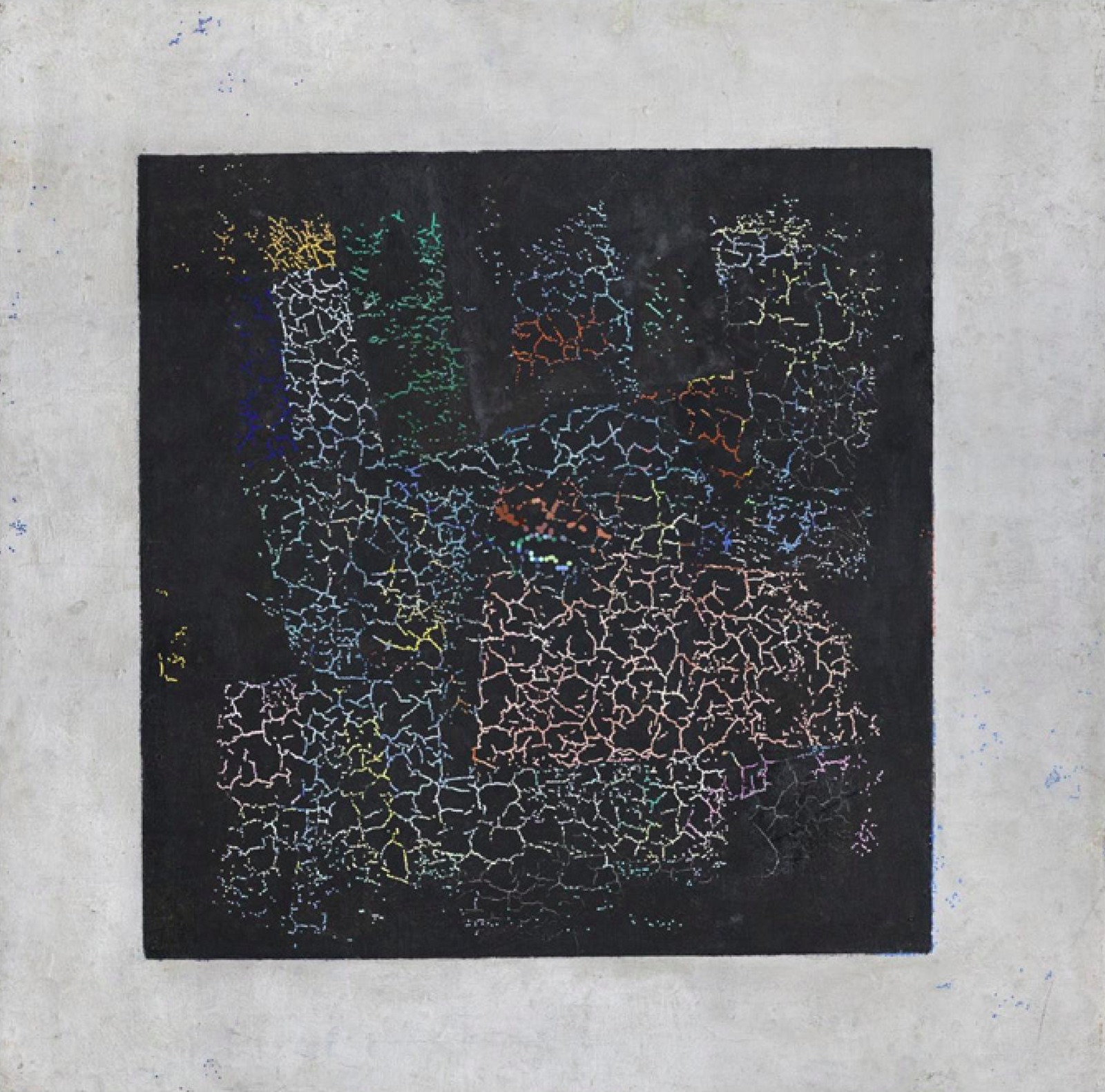
Radiograph of the Black Square. Image courtesy the State Tretyakov Gallery.
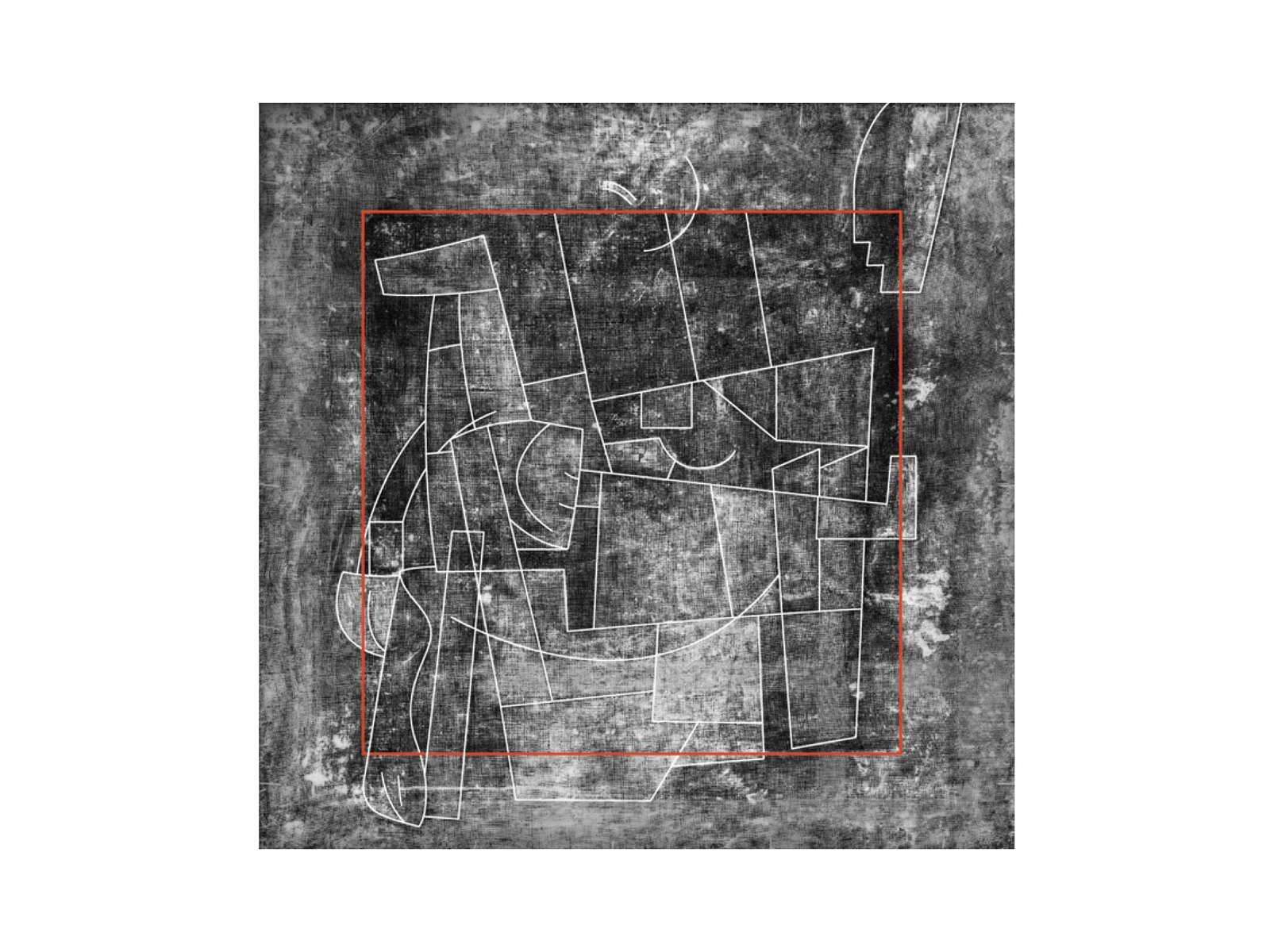
Reconstruction of the bottom layer of the Black Square. Image courtesy the State Tretyakov Gallery.
Circling Back, Circling Black
Let’s return to Dean’s joke: is the joke really about the Black Square, or is it about context? After all, the meat of the concern is in the white margin, the “void outside feeling” as Malevich says, and not the black square, whose underlayers Nakov had revealed in print in 2007. And Malevich’s racist understandings of “primitive men” have also been known for a while. Using the politics of race for its force, the claim about Malevich writing the caption and tracing a genealogy with Bilhaud and Allais has to do with his claim that the Black Square isn’t a painting of anything. What a caption does is make the painting of something, which the caption explains. For example, Vakar proposes that Malevich tentatively wrote the phrase as a way of thinking through his non-referential (or in his terms, “non-objective”) gesture: “After his profound deliberations, trials, and searches, the author seems to ask himself: But is it a picture? Can it be taken seriously?”32Vakar 2015: 24
Malevich definitely obsessed over the possibility of a non-referential gesture, but that doesn’t mean he made the caption (again, Vakar herself later went on to say “it is highly unlikely that the phrase was written by Malevich himself.”33Vakar in Lodder 2019.). However, it’s a fake problem Malevich was obsessing over: it’s not that non-referentiality is impossible, it’s just that Blackness doesn’t intrinsically have anything to do with it, unless you subscribe to primitivist ideologies placing Africans closer to the space of negation, the irrational and irrealis. As such, my staking a claim that Malevich did not make this caption is in service of an argument like Hannah Black’s, not against it: the racism of the work has to do with its claim of non-referentiality, and we should take this seriously rather than always returning to the caption, the yoke to the referential, in order to explain the anti Blackness going on. There’s something very liberal about the claim that he did write it: in this framework, the racism of the work now comes to hinge on the caption. However, as should be clear, the racism of the work doesn’t have anything to do with a caption, but with modernist primitivism around the non-referential.
Is the joke as easy to make as Dean suggests? I think it is, I’m just not telling you. I’ll say: it has to do with discovery. What alternatives are there? You may ask. Building on Francois Laruelle, Dean argues that a “Black Generic” position exists which allows artists to sidestep dualistic binaries (both Christian and secular) which constrain aesthetic possibilities.34Dean, Aria. 2017. On the black generic. NGV Triennial Voices for University of Melbourne. Dichotomies between figuration and abstraction, art and non-art, individual and collective, et al are socially constructed and culturally specific in the extreme.35abreu, manuel arturo. 2021. Sculpting the Black Generic. X-TRA Contemporary Art Quarterly. Older dualistic formations survived the transformations in Europe to emerge as the modernist art object—functionless, autonomous. But an older tradition of non-dualistic abstract aesthetic activity exists: activity which is functional, socially- and spiritually-embedded, and non-autonomous. These traditions of abstraction are not premised on the dualisms I’ve mentioned, which have their root in antiblack notions of Blackness and see Africa as negation or void (in Malevich’s case, as feeling-full negation of the white void). Within them we can find abstraction, which is not so feeble so as to be undone by a simple caption, vandalized or otherwise. Rather than infinitely rehearsing the modernist crisis, or jumping into the next meme trend, we should look instead to these older, more robust traditions and their descendants today.36As I do this with my project An Alternative History of Abstraction, which I mentioned before.
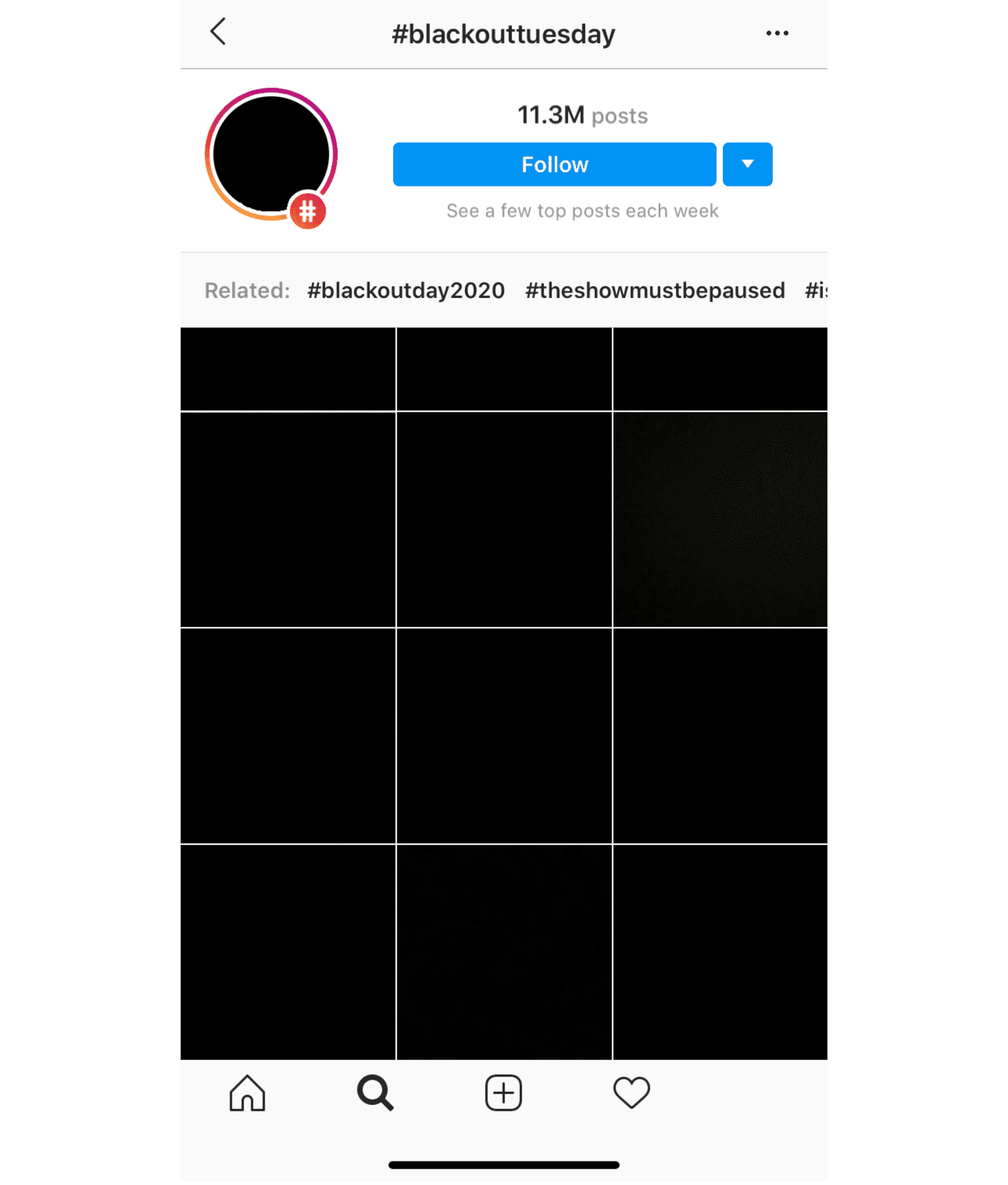
Instagram grid of #blackouttuesday posts
